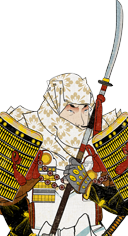
Basic Unit Statistics (can be modified by difficulty level, arts, skills, traits and retainers)
| Recruitment Cost | 1200 | |
| Upkeep Cost | 200 | |
| Melee Attack | 25 | 71% |
| Charge Bonus | 18 | 36% |
| Bonus vs Cavalry | 15 | 50% |
| Melee Defence | 18 | 51% |
| Armour | 5 | 33% |
| Morale | 25 | 50% |
Strengths & Weaknesses
- Excellent versatile infantry.
- Almost unbreakable morale.
- Small unit size leaves them vulnerable to being swamped by massed melee units.
Abilities
- Hold Firm - This temporarily increases defence ability and stops morale from dropping, making the unit, and up to three nearby units, unbreakable for a short time.
- Warcry - Warcry heavily demoralises up to four nearby enemy units, slowing them down and affecting their defence ability for a short time.
Requires
Description
These warrior monks wield fearsome naginata, long polearms that are effective against cavalry and infantry alike.
A warrior with unshakable faith can be very dangerous, for the truly devout have little fear of death. For these monks, faith is not just a matter of conscience, but a weapon. It gives them very good morale in battle. They each carry a naginata, a long staff with a sword-length blade on the end. The long reach makes it effective against cavalry and infantry, but versatility is little protection against missiles. A naginata was weapon similar to the medieval European glaive: a long, wooden shaft with a curved killing blade. The blade varied in length and was, unlike a European glaive, as carefully made as any sword. These distinctive weapons were closely associated with warrior monks. Among the most famous naginata users was Gochin no Tajima, or "Tajima the Arrow Cutter", who fought in the battle of Uji in 1180. Tajima was part of a group of warrior monks pursued by the Taira; he made a stand at a bridge, whirling his naginata with such speed and expertise that arrows bounced harmlessly away.